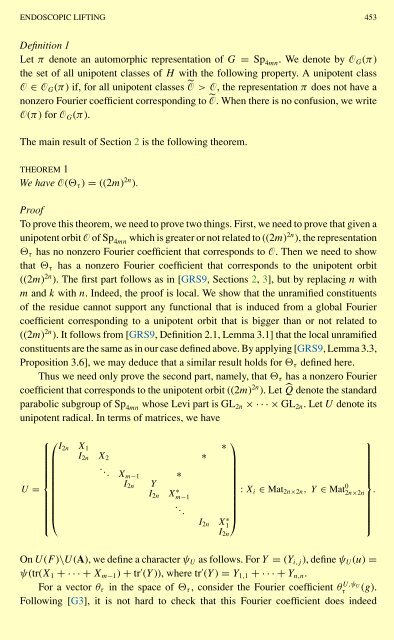A NULLSTELLENSATZ FOR AMOEBAS
A NULLSTELLENSATZ FOR AMOEBAS
A NULLSTELLENSATZ FOR AMOEBAS
You also want an ePaper? Increase the reach of your titles
YUMPU automatically turns print PDFs into web optimized ePapers that Google loves.
ENDOSCOPIC LIFTING 453<br />
Definition 1<br />
Let π denote an automorphic representation of G = Sp 4mn . We denote by O G (π)<br />
the set of all unipotent classes of H with the following property. A unipotent class<br />
O ∈ O G (π) if, for all unipotent classes Õ > O, the representation π does not have a<br />
nonzero Fourier coefficient corresponding to Õ. When there is no confusion, we write<br />
O(π) for O G (π).<br />
The main result of Section 2 is the following theorem.<br />
THEOREM 1<br />
We have O( τ ) = ((2m) 2n ).<br />
Proof<br />
To prove this theorem, we need to prove two things. First, we need to prove that given a<br />
unipotent orbit O of Sp 4mn which is greater or not related to ((2m) 2n ), the representation<br />
τ has no nonzero Fourier coefficient that corresponds to O. Then we need to show<br />
that τ has a nonzero Fourier coefficient that corresponds to the unipotent orbit<br />
((2m) 2n ). The first part follows as in [GRS9, Sections 2, 3], but by replacing n with<br />
m and k with n. Indeed, the proof is local. We show that the unramified constituents<br />
of the residue cannot support any functional that is induced from a global Fourier<br />
coefficient corresponding to a unipotent orbit that is bigger than or not related to<br />
((2m) 2n ). It follows from [GRS9, Definition 2.1, Lemma 3.1] that the local unramified<br />
constituents are the same as in our case defined above. By applying [GRS9, Lemma 3.3,<br />
Proposition 3.6], we may deduce that a similar result holds for τ defined here.<br />
Thus we need only prove the second part, namely, that τ has a nonzero Fourier<br />
coefficient that corresponds to the unipotent orbit ((2m) 2n ).Let̂Q denote the standard<br />
parabolic subgroup of Sp 4mn whose Levi part is GL 2n ×···×GL 2n .LetU denote its<br />
unipotent radical. In terms of matrices, we have<br />
⎧⎛<br />
⎞<br />
⎫<br />
I 2n X 1 ∗<br />
I 2n X 2 ∗<br />
. ..<br />
⎪⎨<br />
Xm−1 ∗<br />
U =<br />
I 2n Y<br />
⎪⎬<br />
I 2n Xm−1<br />
∗ : X i ∈ Mat 2n×2n ,Y∈ Mat 0 2n×2n .<br />
.<br />
⎜<br />
.. ⎟<br />
⎝<br />
⎪⎩<br />
I 2n X1<br />
∗ ⎠<br />
⎪⎭<br />
I 2n<br />
On U(F )\U(A), we define a character ψ U as follows. For Y = (Y i,j ),defineψ U (u) =<br />
ψ(tr(X 1 +···+X m−1 ) + tr ′ (Y )), where tr ′ (Y ) = Y 1,1 +···+Y n,n .<br />
For a vector θ τ in the space of τ , consider the Fourier coefficient θ U,ψ U<br />
τ<br />
(g).<br />
Following [G3], it is not hard to check that this Fourier coefficient does indeed
















